coolant level MERCEDES-BENZ B-CLASS HATCHBACK 2008 Owners Manual
[x] Cancel search | Manufacturer: MERCEDES-BENZ, Model Year: 2008, Model line: B-CLASS HATCHBACK, Model: MERCEDES-BENZ B-CLASS HATCHBACK 2008Pages: 305, PDF Size: 5.1 MB
Page 8 of 305
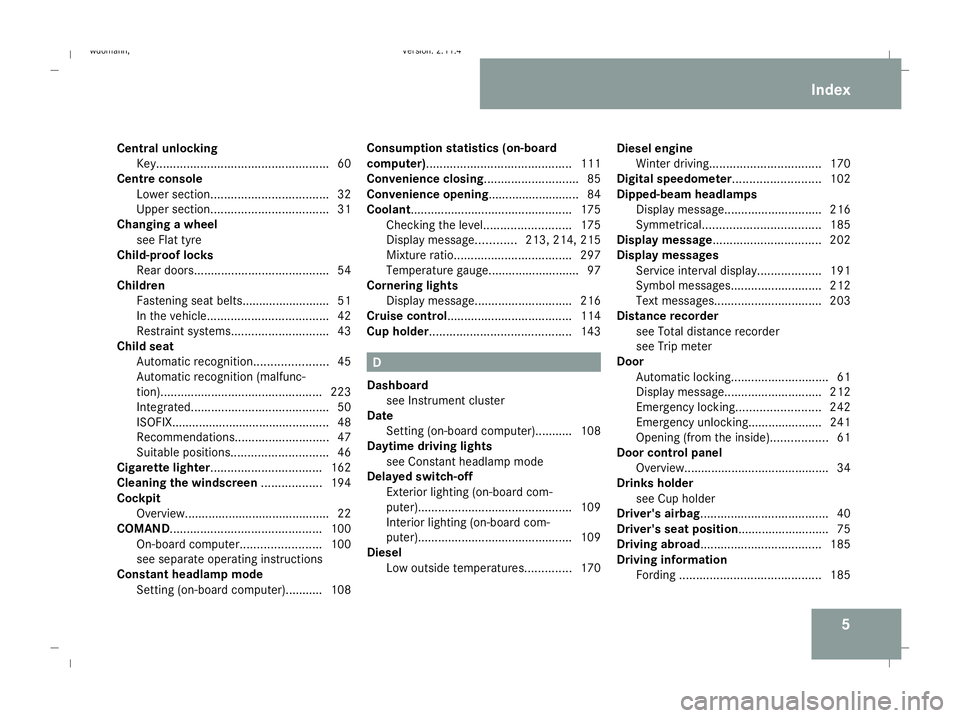
5
Central unlocking
Key................................................... 60
Centre console
Lower section. .................................. 32
Upper section. .................................. 31
Changing a wheel
see Flat tyre
Child-proof locks
Rear doors. ....................................... 54
Children
Fastening seat belts.......................... 51
In the vehicle. ................................... 42
Restraint systems. ............................ 43
Child seat
Automatic recognition ......................45
Automatic recognition (malfunc-
tion). ............................................... 223
Integrated ......................................... 50
ISOFIX............................................... 48
Recommendations. ...........................47
Suitable positions. ............................ 46
Cigarette lighter................................. 162
Cleaning the windscreen ..................194
Cockpit Overview. .......................................... 22
COMAND............................................. 100
On-board computer. .......................100
see separate operating instructions
Constant headlamp mode
Setting (on-board computer).......... .108 Consumption statistics (on-board
computer)...........................................
111
Convenience closing ............................85
Convenience opening ........................... 84
Coolant ................................................ 175
Checking the level. .........................175
Display message ............213, 214, 215
Mixture ratio ................................... 297
Temperature gauge ...........................97
Cornering lights
Display message ............................. 216
Cruise control..................................... 114
Cup holder.......................................... 143 D
Dashboard see Instrument cluster
Date
Setting (on-board computer).......... .108
Daytime driving lights
see Constant headlamp mode
Delayed switch-off
Exterior lighting (on-board com-
puter). ............................................. 109
Interior lighting (on-board com-
puter). ............................................. 109
Diesel
Low outside temperatures. .............170Diesel engine
Winter driving. ................................ 170
Digital speedometer.......................... 102
Dipped-beam headlamps Display message ............................. 216
Symmetrical. .................................. 185
Display message................................ 202
Display messages Service interval display. ..................191
Symbol messages. ..........................212
Text messages. ............................... 203
Distance recorder
see Total distance recorder
see Trip meter
Door
Automatic locking ............................. 61
Display message ............................. 212
Emergency locking .........................242
Emergency unlocking...................... 241
Opening (from the inside). ................61
Door control panel
Overview. .......................................... 34
Drinks holder
see Cup holder
Driver's airbag...................................... 40
Driver's seat position........................... 75
Driving abroad.................................... 185
Driving information Fording .......................................... 185 Index
245_AKB; 2; 7, en-GB
wdomann,
Version: 2.11.4
2008-10-17T11:22:31+02:00 - Seite 5 Dateiname: 6515_1640_02_buchblock.pdf; preflight
Page 100 of 305
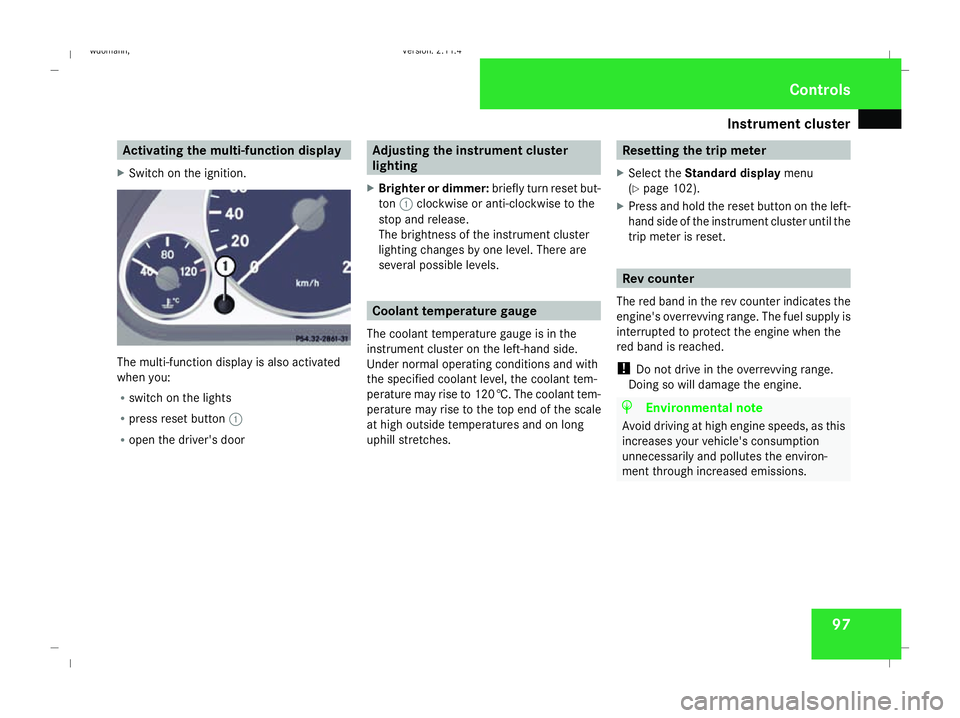
Instrument cluster
97Activating the multi-function display
X Switch on the ignition. The multi-function display is also activated
when you:
R switch on the lights
R press reset button 1
R open the driver's door Adjusting the instrument cluster
lighting
X Brighter or dimmer: briefly turn reset but-
ton 1clockwise or anti-clockwise to the
stop and release.
The brightness of the instrument cluster
lighting changes by one level. There are
several possible levels. Coolant temperature gauge
The coolant temperature gauge is in the
instrument cluster on the left-hand side.
Under normal operating conditions and with
the specified coolant level, the coolant tem-
perature may rise to 120 †. The coolant tem-
perature may rise to the top end of the scale
at high outside temperatures and on long
uphill stretches. Resetting the trip meter
X Select the Standard display menu
(Y page 102).
X Press and hold the reset button on the left-
hand side of the instrument cluster until the
trip meter is reset. Rev counter
The red band in the rev counter indicates the
engine's overrevving range. The fuel supply is
interrupted to protect the engine when the
red band is reached.
! Do not drive in the overrevving range.
Doing so will damage the engine. H
Environmental note
Avoid driving at high engine speeds, as this
increases your vehicle's consumption
unnecessarily and pollutes the environ-
ment through increased emissions. Controls
245_AKB; 2; 7, en-GB
wdomann
, Version: 2.11.4 2008-10-17T11:22:31+02:00 - Seite 97 ZDateiname: 6515_1640_02_buchblock.pdf; preflight
Page 178 of 305
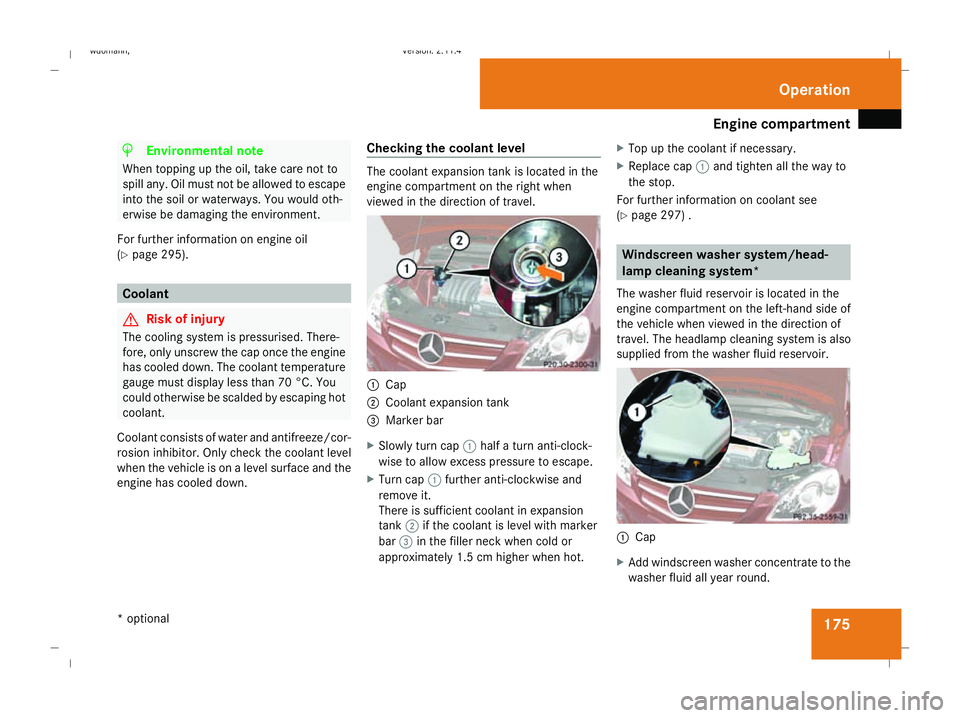
Engine compartment
175H
Environmental note
When topping up the oil, take care not to
spill any. Oil must not be allowed to escape
into the soil or waterways. You would oth-
erwise be damaging the environment.
For further information on engine oil
(Y page 295). Coolant
G
Risk of injury
The cooling system is pressurised. There-
fore, only unscrew the cap once the engine
has cooled down. The coolant temperature
gauge must display less than 70 °C. You
could otherwise be scalded by escaping hot
coolant.
Coolant consists of water and antifreeze/cor-
rosion inhibitor. Only check the coolant level
when the vehicle is on a level surface and the
engine has cooled down. Checking the coolant level The coolant expansion tank is located in the
engine compartment on the right when
viewed in the direction of travel.
1
Cap
2 Coolant expansion tank
3 Marker bar
X Slowly turn cap 1half a turn anti-clock-
wise to allow excess pressure to escape.
X Turn cap 1further anti-clockwise and
remove it.
There is sufficient coolant in expansion
tank 2if the coolant is level with marker
bar 3in the filler neck when cold or
approximately 1.5 cm higher when hot. X
Top up the coolant if necessary.
X Replace cap 1and tighten all the way to
the stop.
For further information on coolant see
(Y page 297) . Windscreen washer system/head-
lamp cleaning system*
The washer fluid reservoir is located in the
engine compartment on the left-hand side of
the vehicle when viewed in the direction of
travel. The headlamp cleaning system is also
supplied from the washer fluid reservoir. 1
Cap
X Add windscreen washer concentrate to the
washer fluid all year round. Operation
* optional
245_AKB; 2; 7, en-GB
wdomann
,V ersion: 2.11.4
2008-10-17T11:22:31+02:00 - Seite 175 ZDateiname: 6515_1640_02_buchblock.pdf; preflight
Page 217 of 305
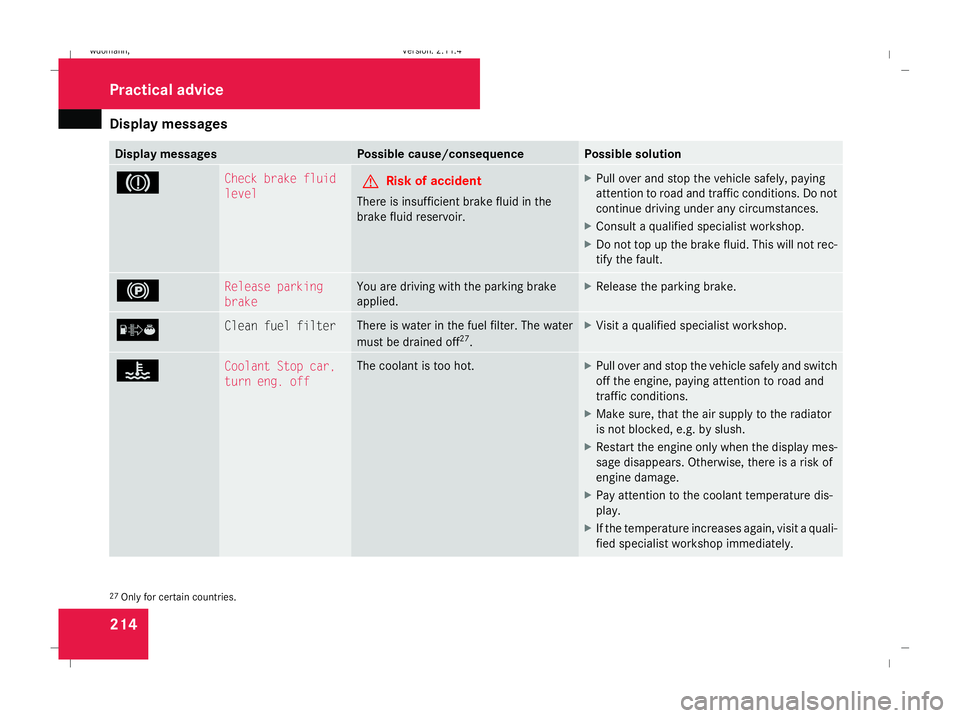
Display
messages 214 Display messages Possible cause/consequence Possible solution
3 Check brake fluid
level
G
Risk of accident
There is insufficient brake fluid in the
brake fluid reservoir. X
Pull over and stop the vehicle safely, paying
attention to road and traffic conditions. Do not
continue driving under any circumstances.
X Consult a qualified specialist workshop.
X Do not top up the brake fluid. This will not rec-
tify the fault. ! Release parking
brake You are driving with the parking brake
applied. X
Release the parking brake. [ Clean fuel filter There is water in the fuel filter. The water
must be drained off
27
. X
Visit a qualified specialist workshop. D Coolant Stop car,
turn eng. off The coolant is too hot. X
Pull over and stop the vehicle safely and switch
off the engine, paying attention to road and
traffic conditions.
X Make sure, that the air supply to the radiator
is not blocked, e.g. by slush.
X Restart the engine only when the display mes-
sage disappears. Otherwise, there is a risk of
engine damage.
X Pay attention to the coolant temperature dis-
play.
X If the temperature increases again, visit a quali-
fied specialist workshop immediately. 27
Only for certain countries. Practical advi
ce
245_AKB; 2; 7, en-GB
wdomann,
Version: 2.11.4 2008-10-17T11:22:31+02:00 - Seite 214Dateiname: 6515_1640_02_buchblock.pdf; preflight
Page 218 of 305
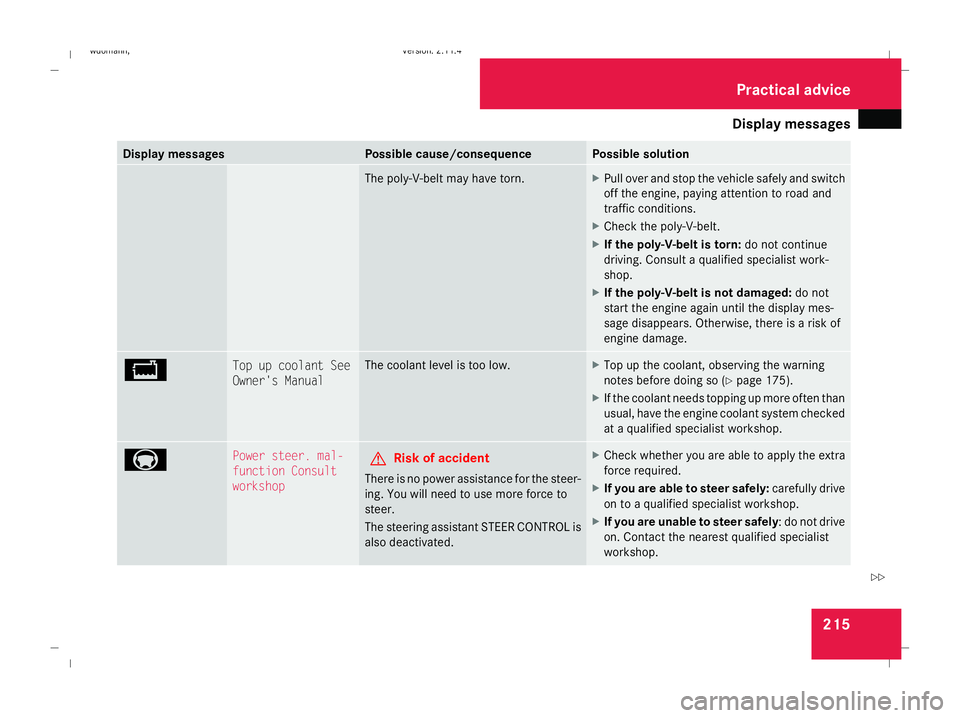
Display
messages 215Display messages Possible cause/consequence Possible solution
The poly-V-belt may have torn. X
Pull over and stop the vehicle safely and switch
off the engine, paying attention to road and
traffic conditions.
X Check the poly-V-belt.
X If the poly-V-belt is torn: do not continue
driving. Consult a qualified specialist work-
shop.
X If the poly-V-belt is not damaged: do not
start the engine again until the display mes-
sage disappears. Otherwise, there is a risk of
engine damage. B Top up coolant See
Owner's Manual The coolant level is too low. X
Top up the coolant, observing the warning
notes before doing so (Y page 175).
X If the coolant needs topping up more often than
usual, have the engine coolant system checked
at a qualified specialist workshop. 3 Power steer. mal-
function Consult
workshop G
Risk of accident
There is no power assistance for the steer-
ing. You will need to use more force to
steer.
The steering assistant STEER CONTROL is
also deactivated. X
Check whether you are able to apply the extra
force required.
X If you are able to steer safely: carefully drive
on to a qualified specialist workshop.
X If you are unable to steer safely : do not drive
on. Contact the nearest qualified specialist
workshop. Practical advi
ce
245_AKB; 2; 7, en-GB
wdomann,
Version: 2.11.4 2008-10-17T11:22:31+02:00 - Seite 215 ZDateiname: 6515_1640_02_buchblock.pdf; preflight
Page 237 of 305
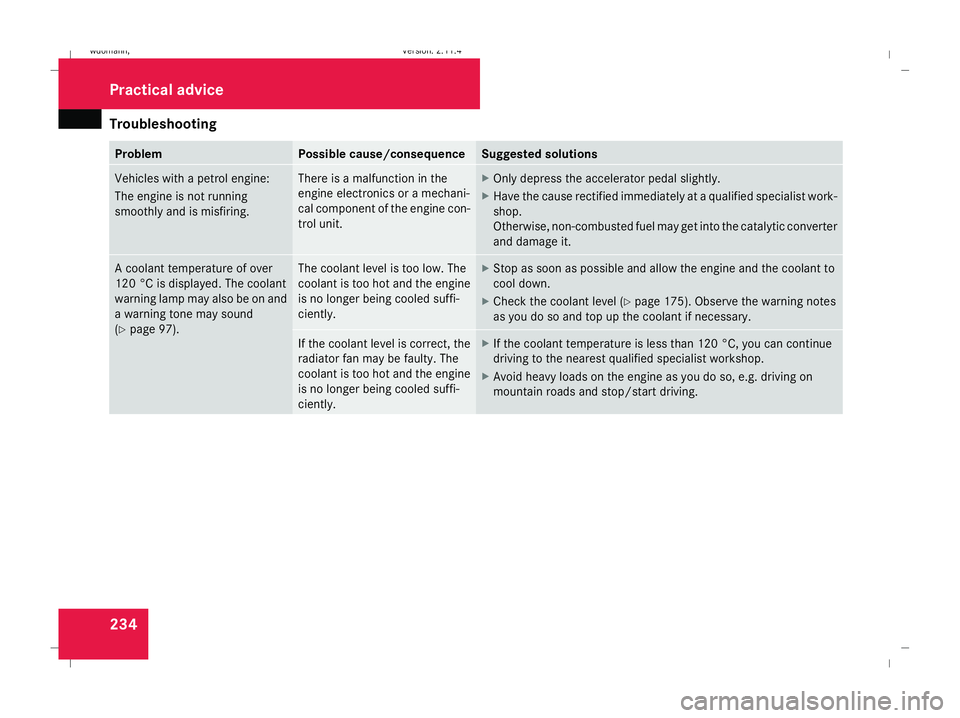
Troubleshooting
234 Problem Possible cause/consequence Suggested solutions
Vehicles with a petrol engine:
The engine is not running
smoothly and is misfiring. There is a malfunction in the
engine electronics or a mechani-
cal component of the engine con-
trol unit. X
Only depress the accelerator pedal slightly.
X Have the cause rectified immediately at a qualified specialist work-
shop.
Otherwise, non-combusted fuel may get into the catalytic converter
and damage it. A coolant temperature of over
120 °C is displayed. The coolant
warning lamp may also be on and
a warning tone may sound
(Y
page 97). The coolant level is too low. The
coolant is too hot and the engine
is no longer being cooled suffi-
ciently. X
Stop as soon as possible and allow the engine and the coolant to
cool down.
X Check the coolant level (Y page 175). Observe the warning notes
as you do so and top up the coolant if necessary. If the coolant level is correct, the
radiator fan may be faulty. The
coolant is too hot and the engine
is no longer being cooled suffi-
ciently. X
If the coolant temperature is less than 120 °C, you can continue
driving to the nearest qualified specialist workshop.
X Avoid heavy loads on the engine as you do so, e.g. driving on
mountain roads and stop/start driving. Practical advice
245_AKB; 2; 7, en-GB
wdomann,
Version: 2.11.4 2008-10-17T11:22:31+02:00 - Seite 234Dateiname: 6515_1640_02_buchblock.pdf; preflight
Page 294 of 305

Service products and capacities
291Service products and capacities
Notes on service products and capaci-
ties
Service products are:
R fuels (e.g. petrol, diesel)
R lubricants (e.g. engine oil, transmission oil)
R coolant
R brake fluid
R windscreen washer fluid
Mercedes-Benz recommends that you only
use those products which have been tested
and specially approved by Mercedes-Benz for
your vehicle and are listed in the Mercedes-
Benz Owner's Manual in the relevant chapter
since:
R parts and service products are matched
R damage caused by the use of non-approved
service products is not covered by the war-
ranty
You can recognise service products approved
by Mercedes-Benz by the following inscrip-
tion on the containers:
R MB-Freigabe (e.g. MB-Freigabe 229.51)
R MB Approval (e.g. MB Approval 229.51) Other designations or recommendations that
relate to a level of quality or a specification in
accordance with an MB Approval have not
necessarily been approved by Mercedes-
Benz.
You can obtain further information from any
Mercedes-Benz Service Centre. G
Risk of injury
When handling, storing and disposing of
any service products, please observe the
relevant regulations, as, otherwise, you
could endanger yourself and others.
Keep service products away from children.
To protect your health, do not allow service
products to come into contact with your
eyes or open wounds. See a doctor imme-
diately if any service product is swallowed. H
Environmental note
Dispose of service products in an environ-
mentally-responsible manner. Fuels
G
Risk of explosion
Fuel is highly flammable. Fire, naked flames
and smoking are therefore prohibited when
handling fuels.
Switch off the engine before refuelling. G
Risk of injury
Do not allow fuel to come into contact with
skin or clothing.
Allowing fuels to come into direct contact
with your skin or inhaling fuel vapours is
damaging to your health.
Tank capacity Total capacity 54 l
Of which reserve
fuel
Approximately 6 l
!
Do not use petrol to refuel vehicles with a
diesel engine. Do not use diesel to refuel
vehicles with a petrol engine. Never mix
diesel with petrol. Even small amounts of
the wrong fuel result in damage to the
injection system. Damage resulting from Technical data
245_AKB; 2; 7, en-GB
wdomann,
Version: 2.11.4
2008-10-17T11:22:31+02:00 - Seite 291 ZDateiname: 6515_1640_02_buchblock.pdf; preflight